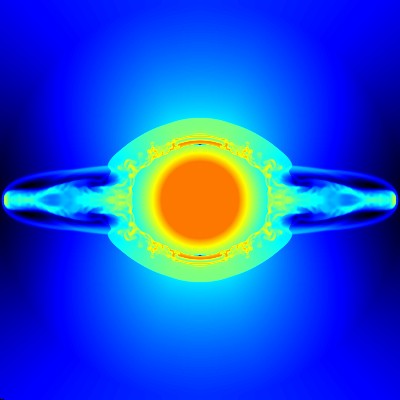Can the "protrusion" discovered by Blondin, Lundqvist and Chevalier (ApJ, 472, 257) explain the "jet-like" appearance of the young SNR, Cassiopeia A? The image below highlights the X-ray emission from Si, as seen by the Chandra X-Ray Observatory (Hwang et al. ApJ 615, L117).
![]()
The image below is a 2D slice from a 3D simulation of a SSDW propagating into an axisymmetric circumstellar medium with a density in the equatorial plane (aligned vertically in this image) that is 4 times denser than the CSM in the polar directions. The simulation is computed on a spherical grid with the polar axis (a source of constant pain for computational physicists) aligned vertically in this image, such that any numerical artifacts of this coordinate singularity are confined to a region in the equatorial plane of the CSM distribution. Here is ananimation of this 3D simulation in mpg format (3.5 MB).

The image below shows a 3D rendering of one half of this supernova remnant protrusion. The transparent blue surface shows the location of the forward shock, and the colored interior surface outlines the shocked stellar ejecta. The ejecta is colored by the quantity vt/r, which would be unity for un-decelerated ejecta. The red filaments of ejecta streaming along the axis of the jet have vt/r of approximately unity.